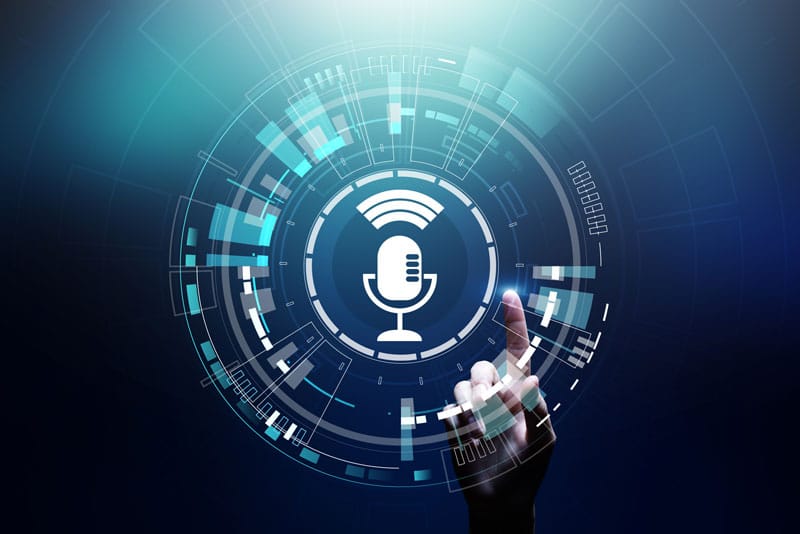
Voice artificial intelligence (AI) has revolutionized communication in many industries, including the healthcare sector. Speech recognition in AI is used by physicians to convert dictation into text in real-time and the notes are often sent out to a medical transcription service company for editing and review. But this is not the only way AI is transforming the medical industry. Among other things, the COVID-19 pandemic is pushing digital transformation in health in which AI adoption plays a major role.
According to reports, 128 million people in the U.S. use voice assistants. Advances in machine learning and deep learning allow voice assistants to carry out even complex commands. Healthcare chat bots are expanding and changing how care is delivered, and their use is expected to grow at a rapid pace.
“The healthcare conversational AI market is growing at a 25%–35% compound annual rate,” says Brian Kalis, Managing Director, Health Strategy, Accenture. “Companies like Microsoft, Amazon Web Services (AWS), and Google Cloud are investing heavily in technologies specifically designed for healthcare and partnering with health systems to pilot their innovations” (Health Leaders Media).
Let’s take a look the many applications of voice AI in healthcare and the benefits for patients and providers.
Voice AI and Patients
- Healthcare information: AI bots help patients get answers to their questions about signs and symptoms, illnesses, treatment options, potential side effects of medications, drug availability, and wellness tips. Healthcare bots like Your. MD allow patients to check their symptoms, ask a question and take a health quiz.
- Connect with healthcare services: Patients can use a physician’s chat bot to book appointments directly. The bot can allocate a physician, send an email to the provider with the patient’s information, and schedule an appointment. Voice based assistants will tell the patients what they need to do to manage the process, such as upload their reports if their medical problem requires it. In fact, bots became a stress-free way to schedule medical appointments during the COVID-19 pandemic when telemedicine adoption became widespread. Patients can even receive appointment reminders via a bot.
- Mental health support: There are AI bots to help with mental health. Patients can directly share their distress with the virtual assistant which can interpret their emotions from the tone of their voice. AI systems can identify, triage, analyze or guide patients with mental health concerns very efficiently. Wysa is an example of an emotionally intelligent chatbot that uses a combination of tools and techniques like Dialectical Behavior Therapy (DBT), evidence-based CBT, and guided meditation to help manage thoughts and emotions.
- Better manage treatment regimens and chronic conditions: Patient adherence is a major concern, especially with virtual care. Healthcare bots help patient manage their own health and treatment regimens. Take Mabu, Catalia Health software that is specially designed to help patients manage their chronic conditions, including rheumatoid arthritis and cancer. This robot asks patients how they are feeling and based on their answer, can tell them that they might want to contact their doctor (news.mit.edu).
Voice AI and Physicians
- Documentation support without voice commands: Error-free electronic health record (EHR) documentation is necessary to ensure continuity of care as well as for medical billing and regulatory compliance. But creating and reviewing notes can bog down physicians’ time. AI bots provide real-time support for clinical documentation. They reduce the administrative burden related to note-taking and allow physicians to focus on value-added care. Today, voice AI has transformed this process. Nuance’s Saykara is an AI-powered healthcare voice assistant that works without any voice commands during a physician-patient encounter.
This bot:
- Listens in on patient-physician conversations or from summaries provided by physicians’ post-encounters with patients
- Uses speech recognition and natural language processing technology to interpret and transform the content into notes, orders, referrals and more
- Enters both structured and unstructured data directly to the EHR the process of producing clinical notes in real-time
By automating the process of producing clinical notes in real-time, Kara minimizes the physician’s after-hours charting and records entry burden.
- Provide answers for FAQs: Physicians can use a chatbot to answer their frequently asked questions. They can communicate on matters relating to symptoms, insurance coverage, claims, documents, business hours, etc.
- Billing and claims: With easy access to patient information as well as queries, physicians can pre-authorize billing payments and other requests received from patients or healthcare establishments. Patients can also find relevant information on their current insurance coverage and track the status of a claim.
- Patient feedback: Chatbots can collect feedback from patients on the physician’s services.
Challenges of Conversational AI
Like all innovative solutions, voice AI also comes with certain challenges. The first is security. Chatbots collect patient information by asking simple questions about name, address, symptoms, current doctor, and insurance details. This information is then stored in the medical facility system to enable patient admission, symptom tracking, doctor-patient communication, and medical record keeping. This could pose a security problem as users usually are not aware of how their sensitive personal identifying information is treated, used, stored, or even shared.
Another concern is regarding how well they can catch emotions. Experts are sceptical about whether chatbots can help patients with emotional trauma. To increase outreach to patients with emotional chatbots, physicians should also include face-to-face (or monitor-to-monitor) interactions with patients. Also, voice assistants can have conversations only in English and not in other languages. This limits their use for many people.
While voice AI is here to stay, when it comes to accurate EHR documentation, medical transcription services are still relevant. AI-generated documents generated in real-time have to be reviewed for accuracy and partnering with a medical transcription company is the best way to do this.


